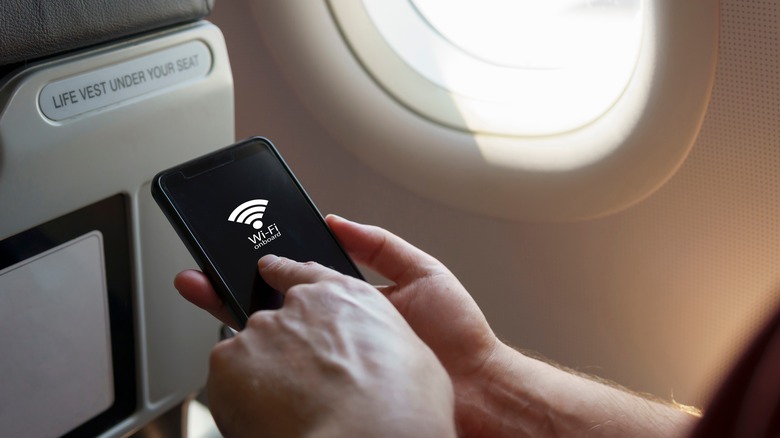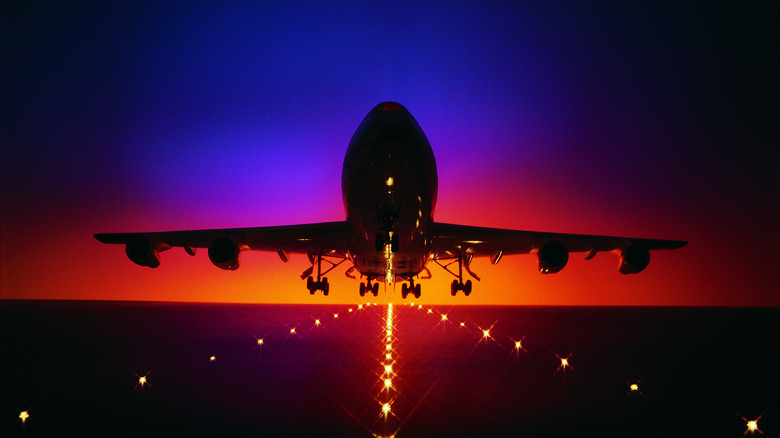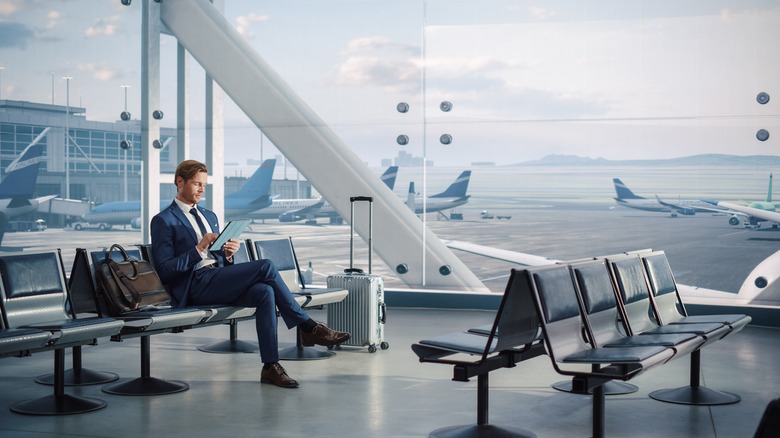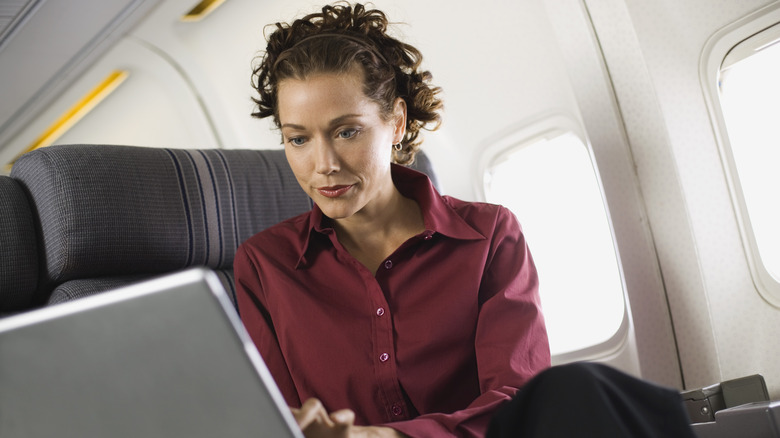Is In-Flight Wi-Fi Worth The Cost Or Should You Save Your Money?
Longer flights can get a little dull at times. If you're only in the air for an hour or two, you can usually occupy yourself without going online, but what about the flights that take six, eight, or even 12 hours? That's a large chunk of time, and whether you need it for work or extra entertainment, you might want to fill that time with internet access. This often means buying in-flight Wi-Fi, but is it really worth the money?
These days, most airlines offer access to in-flight Wi-Fi. This can help kill some time in the absence of a cellular connection. While you may lose your phone signal throughout your flight (or even rarely have it at all), onboard Wi-Fi is meant to be a more stable and faster alternative.
Unfortunately, there are many downsides to buying into the service, and it's important for you to know them before you decide to spend your money after takeoff.
Types of in-flight Wi-Fi
Before you can judge whether in-flight Wi-Fi is worth it or not, it's important to note what type of Wi-Fi is being offered by the airline. Keep in mind that your own cellular connection is not likely to work, because telephone networking doesn't function properly after you reach a certain height. Don't rely on cellular data if you want to go online during your flight — it will only work for a short time.
Depending on the plane and the route, you'll find that the Wi-Fi will either come from overlapping ground stations or from communication satellites. Each connection method has some benefits and some downsides.
The ground stations beam signals into the sky that the aircraft is then able to pick up and redistribute throughout the plane, enabling Wi-Fi for the passengers. While it sounds good on paper, you may find that the connection tends to get spotty. You'll especially feel this on international flights where you cross a large, deserted area that may not have any stations — oceans and seas are common culprits here. This type of connection is referred to as air-to-ground (ATG).
Satellite connections (also known as SATCOM) work differently. Units based on the ground contact satellites based in orbit, and then the satellites direct the signal toward the airplane. This can mean better coverage and higher speeds, but satellite Wi-Fi is also often more expensive as a result.
How much does in-flight Wi-Fi cost?
In-flight Wi-Fi is not perfect, but one of the upsides of it is that you can pick a plan that suits your needs. Whether the connection will actually be able to deliver on the promised speeds remains to be seen, but more on that later. When choosing the right Wi-Fi for your flight, you're likely to be given a few options, each with a different price.
Some airlines, such as Delta Air Lines, may offer free Wi-Fi. This may be true for all passengers, or just those that are regular flyers or subscribers (as is the case with Delta). American Airlines lets you access its own website when you're onboard, but that's all you're getting until you pay for Wi-Fi access.
You may find that many airlines with wide Wi-Fi coverage also offer packages. This can include a day pass or a monthly pass, and in some cases, an annual pass; all of those give you Wi-Fi access across all your flights. The prices can be pretty steep — American Airlines charges $49.95 for a monthly plan.
For a single flight, you may pay anywhere between $5 and $50 for Wi-Fi access. The prices vary depending on speed, coverage, and connection type. Some plans only give you access to certain sites, such as Facebook Messenger. Others open up the whole of the internet, but of course, many websites and services may still be banned. As an example, support for streaming services isn't always included with in-flight Wi-Fi plans, because streaming consumes a considerable amount of data. Check with your airline ahead of your flight to verify the exact pricing.
How fast is in-flight Wi-Fi?
It should come as no surprise that in-flight Wi-Fi is considerably slower than the internet speeds we've all grown used to in our homes. When measuring internet speed, both download and upload speeds need to be taken into consideration. However, for the purpose of in-flight Wi-Fi connections, you will mostly care about downloading, which covers how fast websites are to load, how fast you're downloading files, and whether streaming apps and games work smoothly.
According to Speedtest, the median download speed in the United States is at around 80 Mbps for mobile connections, and 195 Mbps for fixed broadband. These speeds vary based on location and internet service provider (ISP). Unfortunately, in-flight Wi-Fi is incapable of reaching these averages most of the time.
Even if the plane receives a speed of around 100 to 300 Mbps, that doesn't translate to the speed you'll be seeing on your device. This is because that bandwidth is split among all the passengers who are trying to use in-flight Wi-Fi, so you might be left with very little if many other passengers are attempting to connect.
Some ATG connections offer extremely low speeds along the lines of 3-10 Mbps, but a satellite connection can usually provide 10-20 Mbps for a basic package, and even up to 80 Mbps. Basic packages are cheaper, so to get to that higher threshold, you may need to spend a hefty amount.
It's also important to note that in-flight Wi-Fi can be spotty, and even with a satellite connection, you may get disconnected or see massive drops in connection speed frequently. The weather, your current location, and the aircraft itself all play a part in how reliable the Wi-Fi can be.
Is in-flight Wi-Fi worth your money?
When all is said and done, in-flight Wi-Fi can be a good option for some flights — but it may also turn out to be wasted money. Many variables come into play when making the decision between buying in-flight Wi-Fi and skipping it. When making your choice, factor in things like the airline, the packages and speeds that it offers, and the prices. If you're able to, try to find out whether your flight uses ATG or SATCOM Wi-Fi, because the former is often not worth it if you're on an overseas flight.
Given the current pricing of in-flight Wi-Fi, and the fact that the connection is likely to get pretty spotty, it's usually better to go without it. Most airlines offer in-flight entertainment if you're bored, so you can usually pick something to watch. If you're using Netflix or a different streaming service, you might be able to download the show or movie you'd been hoping to see and watch it offline on the plane.
Keep in mind that even if you were hoping to watch Netflix online on your flight, it may not be possible — it might be blocked, and even if it's not, the connection may be too poor for you to stream videos.
If you travel frequently and want to be able to get some work done on your flight, you can try out in-flight Wi-Fi once and see for yourself if it's worth it. Remember that the connection will vary based on the plane and the route, though, and most of the time you'll want to save that money for something else instead.




